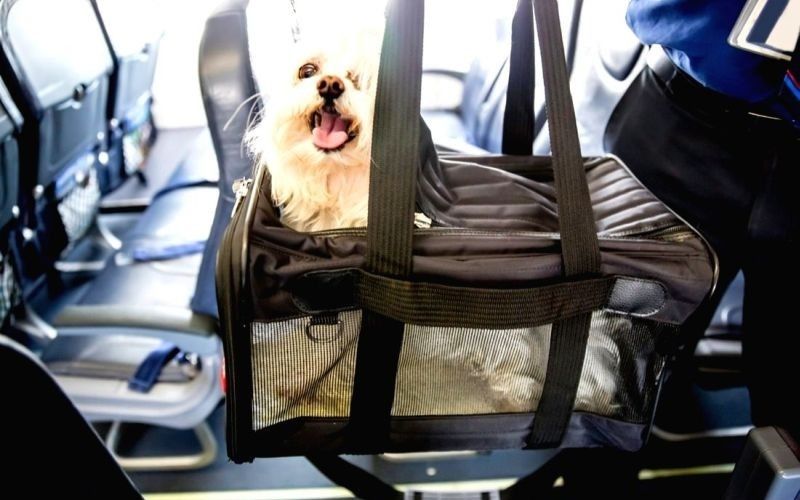While many breeds make excellent emotional support dogs, a few are particularly suited for regular travelers. Planes might stress your dog out depending on their size and temperament, so choose a breed that has a calm demeanor and is easily suited to a travel environment.
Travelers should look at the breed’s activity requirements and behavioral traits when seeking emotional support dogs. Despite the fact that a dog may fit under an airplane seat, breeds that demand a lot of exercise will be unhappy travelers.
We’ve put together a list of dog breeds that can fit under an airplane seat and make great emotional support dogs:-
Yorkshire Terriers

Yorkshire Terriers are 8 to 9 inches tall at the shoulder and weigh 4 to 7 pounds, making them small enough to fit beneath an airplane. This means you can fly with your emotional support dog on your next vacation! Yorkies don’t need much exercise, so they can sleep in their box next to their feet while being calm and relaxed.
King Charles Cavalier Spaniel

Despite the fact that many people are attracted to Cavaliers because of their large eyes and floppy ears, the breed’s adaptability to any owner’s lifestyle makes it an outstanding choice for an emotional support dog. Cavaliers are social dogs who get along well with other dogs, so they’re a terrific fit for any environment. Because of their short height of just over a foot, they’re very easy to travel with.
Pomeranians

Pomeranians require the same amount of exercise as larger breeds but are not confined by the same environmental constraints. Because of their short height, they can channel their energy into any home. Pomeranians, with a height of 6 to 7 inches and a weight of a household brick, may easily fit beneath an airline seat.
Poodle Miniature

These intelligent canines are good emotional support dogs because they have a strong desire to please their owners. Because of their intelligence, they are also simple to train, which is an important factor to consider when selecting a breed for an emotional support dog. While not as “fun-sized” as their “toy” poodle cousins, miniature poodles grow to be little more than 10 inches long, allowing them to fit easily beneath an airplane.
Jack Russel Terriers

If you’re looking for a sociable dog who appreciates strong, personal bonds with its owner, look no further. Jack Russell Terriers are easygoing, travel-friendly canines. With a height of 10 to 12 inches, Jack Russell Terriers are small enough to fit into airplane carriers. Furthermore, their energetic demeanor makes them perfect emotional support dogs for folks who want a pet that wants continual attention.
Boston Terrier

The Boston Terrier is just large enough to fit inside a travel carrier under an airplane, about 15-17 inches tall. This breed is recognized for being people-oriented, adaptable to new circumstances, and simply a happy animal in general.
Welsh Corgis Pembroke

These dogs, which are little about 12 inches tall, are extremely devoted and family-oriented. They are excellent emotional support dogs for anyone looking for a loyal companion in a little package.
Maltese

The Maltese, one of the most beautiful white dogs, is tiny, joyful, and courageous. These little dogs, which weigh less than seven pounds and stand between eight and eleven inches tall, fit nicely under an aircraft seat.
Shih Tzu

The terms “regal and majestic” spring to mind when thinking of the gorgeous Shih Tzu. These gorgeous canines are ideal travel companions thanks to their extroverted temperament, sociability, and nice demeanor.
Chihuahuas

Although Chihuahuas are small enough to fit in a lady’s purse, they have the attitude and enthusiasm of a big dog. Because they weigh between three and six pounds, Chihuahuas are acceptable with most airline-approved soft-sided and hard-sided carriers.
Pekingese

Pekingese with a weight of 14 pounds or less and a length of 6-9 inches will fit in the cabin of various carriers.
Dachshunds miniature

With their short legs, miniature Dachshunds are also small enough to ride in the cabin! Miniature Dachshunds are approximately 5-6 inches tall and weigh less than 11 pounds.
Havanese

Another fluffy white dog that may or may not meet the height standards of your airline!
The average Havanese weighs between 7 and 13 pounds. 5 inches to 11.5 inches
Brussels Griffon

The magnificent Brussels Griffon is an unusual canine breed that may ride in the cabin with you. Brussels Griffons typically weigh 10-12 pounds and stand 7-11 inches tall.
Bichon Frise

A Bichon Frise makes an excellent travel companion. These fluffy white dogs are easy to train, sociable to everyone they meet, and don’t get easily frightened by loud noises. They’re also one of the most affectionate tiny canines you’ll ever meet.
Terrier West Highland White

If your Terrier can travel in a cabin, they should be OK flying. Just be sure they don’t have any health issues that would make flying dangerous. Their usual weight is 15-20 pounds, and they stand between 10 and 11 inches tall.
Australian Terriers

Australian Terriers with pointy ears are bold and affectionate. They’re also great for flying—as long as they fit on the plane. Your Australian Terrier might just fit within your airline’s weight and height restrictions. The average puppy weighs 15-20 pounds and stands 10-11 inches tall.
Papillons

Another small breed that does well on planes is the Papillon. They must adhere to the weight restrictions imposed by most airlines. The average Papillon weighs between 5 and 10 pounds and is between 8 and 11 inches tall.
Toy Poodles

They might fit beneath one of the taller aircraft seats. The average Toy Poodle weighs 4-6 pounds and stands 10 inches or less tall.
Pugs

Due to their size, your pug will most likely only fit beneath some aircraft seats, weighing 14-18 pounds and measuring 10-13 inches.
Japanese Chin

The average Japanese Chin weighs 7-11 pounds and stands 8-11 inches tall.
Lhasa Apso

These vibrant, inquisitive puppies are a joy to be around. Lhasa Apsos weigh 12-18 pounds and stand 10-11 inches tall on average.
You may also take a look at our post for the best dog breeds for air travel.
Traveling With Pet Dogs
It’s not always a smart idea to take your pet dog for a journey, but there are times when it’s important. The issue is that logistics can be complex, with costs, documentation, and a number of laws and regulations to navigate, many of which differ from one airline to the next.
Even so, you can figure it out and make sure your dog has a pleasant and safe journey.
In short, the best advice is to talk to your veterinarian and your airline about your alternatives.
The Difference Between Cabin & Cargo
In-cabin

In general, your dog can travel in the cabin if its carrier fits under the seat in front of you. That would be a dog weighing up to 20 pounds. Of course, the amount of under-seat space varies per aircraft, and airlines often limit the number of pets allowed each flight – which is why you should double-check with the airline.
Your dog will not be able to purchase an additional seat. Traveling with a dog in this manner, effectively as carry-on luggage, frequently results in a lesser charge than flying in the plane’s belly. A pet in its carrier, by the way, counts as a carry-on bag.
As Checked Luggage Or Shipping Cargo

Flying as cargo in a pressurized, temperature-controlled compartment similar to the passenger cabin is the second alternative — and the only choice for larger pets. These dogs fly either as checked baggage on the same trip as you or as shipment cargo, often known as manifest cargo or air transport. Check with your airline once again. For example, Delta Air Lines won’t let you order a pet shipment through Delta Cargo until 14 days before departure.
You must follow airline laws regarding your dog’s age and weight whether you choose cabin or cargo. United Airlines, for example, needs puppies to weigh at least 2 pounds and be at least ten weeks old.
What Size Dog Will Fit Beneath An Airplane Seat?
The maximum size of the carrier allowed on the plane is determined by each airline. United Airlines, for example, accepts carriers that are no longer than 18 inches long and no taller than 11 inches. For most airlines, this is an average estimate; some may vary somewhat. Before doing anything else, make sure to double-check the approved measurements.
Not only must your dog meet these specifications, but it must also be the appropriate weight. The total weight of your dog and the carrier must be less than 20 pounds, according to most airlines. Some do not impose such restrictions, but they do require that your dog be small enough to fit comfortably beneath the seat.
How Much Does Traveling With Your Dog Cost?
Taking a vacation with your four-legged companion appears to be a fantastic idea. You’ll not only get to try something new, but you’ll also get to do it with your dog.
However, while bringing man’s best friend along on your next epic expedition may seem like a great idea, it can come at a price.
Pets that fly as cargo frequently cost more – on American Airlines, for example, pets checked as luggage cost $200 each trip.
Preparing The Documentation For Traveling With A Dog
Even without pets, flying may be a hassle. All of the laws, regulations and security checks can be inconvenient at times. However, as with people, prior planning and comprehension of these protocols will make your pet’s takeoff go more smoothly.
First and foremost, always obtain a health certificate from your veterinarian. Some airlines will require this documentation, while others will not. Regardless of the airline’s pet policy, this piece of paper is required for any pet owner who wants to travel with their pet. Remember that this paperwork must be recent, as most airlines that accept pets on board will require it to be less than ten days old.
Second, talk to your veterinarian about getting a pet passport. Animal companions with passports can travel to any member country without having to go through quarantine, according to the Pet Travel Scheme(PETS). The United States, Canada, Australia, New Zealand, and European Union countries are among the members. Any other country will need proof of the pet’s complete immunization, particularly against rabies.
Recognize The Needs And Limitations Of Your Dog’s Health.
Consult your veterinarian to ensure that your dog is fit to travel by plane. Because it can be difficult for pug-nosed dogs like boxers and Boston terriers to breathe at high altitudes, several airlines refuse to allow them to fly.
According to the airline industry association Airlines for America, you may also need a health certificate from a veterinarian seven to ten days before your flight.
How To Stop Your Dog From Barking While Flying
Man’s finest travel companion could also be his toughest. While ‘pet-friendly has become synonymous with modern travel—hotels, cruise ships, and airlines all welcome our four-legged companions—flying with your dog may result in barking, cries, and a desire to exit the aircraft.
Why? The answer isn’t as simple as it appears.
During a flight, dogs may become agitated for a variety of reasons. Unfamiliar environments and being up and personal with strangers, for example, may trigger anxiety.
Engine noise, pitch variations, altitude changes, and air pressure changes can all cause whining and barking. Even worse, if your dog isn’t used to being in a cabinet, confinement can be frustrating or even terrifying.
Dogs are quite clever at figuring out how to avoid being ignored. They may soon learn that an ashamed owner would lavish immediate attention or food goodies on them in a desperate attempt to keep them quiet throughout a flight.
Airlines That Allow Pets
Here are some instances of airlines that allow pets to travel with them, along with their weight restrictions:
- America Airlines is an airline based in the United States. The combined weight of the pet and the carrier should not exceed 20 pounds. Pets are not permitted in the cabin on international or 12-hour flights.
- Alaska Airlines is an airline based in Anchorage, Alaska. This company will also allow you to bring your pet with you. The weight restriction is similarly set at 20 pounds. A return flight will set you back an additional $200.
- Delta This one allows your pet to fly without weight restrictions, but it must be comfortable, as previously stated.
- Air France is a French airline. Animals weighing up to 17 pounds are allowed to fly in-cabin with Air France. Others will be forced to travel via freight or in the hold.
Airlines Have Banned Some Dog Breeds.
The majority of international airlines have a list of dog breeds that are not permitted to fly. Airlines frequently prohibit dogs from flying in certain weather and temperature circumstances.
Short-headed dog breeds and bully dog breeds are two notable dog breeds that are prohibited from flying.
Due to their incapacity to breathe easily and cool down, AEGEAN will not accept snub-nosed animals as checked baggage or air freight as a precaution.
Dog Breeds With A Shorter Head Or Brachycephalic Head
Dog breeds with shortened heads, often known as brachycephalic dogs, have short noses and muzzles.
Many airlines do not allow these breeds to fly because of their short noses, which might cause breathing problems. When they fly at high altitudes or in the cargo hold, where temperatures change, their respiratory problems sometimes increase.
Breeds Of Bully Dogs
Breed Specific Legislation is sometimes blamed for airline bans on bully dog breeds. As a result, many airlines have banned species like the American Pit Bull Terrier and the American Staffordshire Terrier from flying.
List Of Bully Dogs
| American Bulldog | English Bulldog |
| English Mastiff | Boston Terrier |
| Boxer | Bull Mastiff |
| Bull Terrier | Cane Corso Italiano |
| Caucasian Shepherd Dog | Dogo Argentino |
| French Bulldog | Great Dane |
| Neapolitan Mastiff | Olde English Bulldogge |
| Pug | Rottweiler |
| Staffordshire Bull Terrier | American Pit Bull Terrier |
| American Staffordshire Terrier |
Best Pet-Friendly Airlines In The United States
Each airline has its restrictions for traveling with a pet, but practically all of them need the carrier to provide enough space for your pet to stand, turn around, and lie down, as well as fit below the seat. If you’re flying with checked bags, the carrier should be well ventilated on all sides.
Many airlines limit the number of pets allowed in the cabin per trip, so be sure to check each airline’s policy before booking your pet’s flight.
American Airlines
Small pets must be at least eight weeks old, and their total weight must not exceed 20 pounds.
More information you should be aware of: You should contact American Airlines customer service as soon as possible before your flight to reserve a spot for your pet. Pets traveling in the cabin with you must be kept in their container under the seat for the duration of the journey. Pets are not permitted in the cabin on American Airlines flights to or from Hawaii, Jamaica, Brazil, Chile, Uruguay, Argentina, or Colombia, or on any transatlantic/transpacific flights.
How To Get Your Pet Ready For A Trip
Pets are members of the family, and flying with them necessitates the same level of planning as flying with children! Once you’ve determined that you’ll be traveling with your pet, make an appointment with their veterinarian around a week before your journey.
Your veterinarian will be able to inspect your pet and issue a travel health certificate, ensuring that your pet is ready to travel. Your pet will also need to remain in a carrier for the duration of your travel, so if they aren’t used to it, you should practice with them by putting them in for an hour or more each day leading up to the trip, especially if it will be a long flight.
Make sure your pet has all of the food, drink, and toys they require on the day of your journey! Check that you have all of the essential documents and arrive early at the airport to ensure that your pet is settled in before the journey.
Conclusion
As you might expect, different airlines have varying restrictions when it comes to pet travel. To avoid any misunderstandings later, contact your preferred airline as soon as possible.
According to the Humane Society of the United States, pets should only be traveled if absolutely required. It can be traumatic at times, so think about your alternatives carefully. However, we believe we’ve answered your question about whether or not small dogs are allowed to travel in the cabin.
